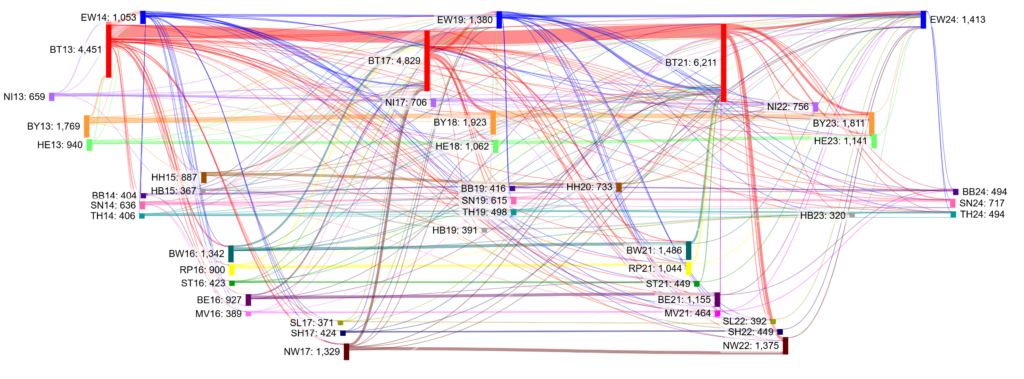 Ohne Kandidaten gibt es keine Wahlen. Die von den Parteien aufgestellten Wahlbewerber erfüllen somit eine wichtige Funktion für das Gelingen von Wahlen und parlamentarischer Demokratie insgesamt, indem sie den Wählerinnen und Wählern eine Auswahl ermöglichen. Im Rahmen des Projekts zur Kandidatenaufstellung für den Bundestag wurde untersucht, wer wen warum für eine Kandidatur auswählt. Auf diesen Erkenntnissen aufbauend, fragt das IParl im CandiData-Projekt nach den langfristigen Entwicklungen in der Kandidatenrekrutierung. Treten weitgehend dieselben Kandidatinnen und Kandidaten bei jeder Wahl an oder werden immer wieder neue Personen aufgestellt? Welchen Mustern folgen die Kandidaturen im elektoralen Mehrebenensystem der Bundesrepublik Deutschland? Unter welchen Bedingungen werden Bewerberinnen und Bewerber so ausgewählt, dass der Einzug ins Parlament gelingt.
Ohne Kandidaten gibt es keine Wahlen. Die von den Parteien aufgestellten Wahlbewerber erfüllen somit eine wichtige Funktion für das Gelingen von Wahlen und parlamentarischer Demokratie insgesamt, indem sie den Wählerinnen und Wählern eine Auswahl ermöglichen. Im Rahmen des Projekts zur Kandidatenaufstellung für den Bundestag wurde untersucht, wer wen warum für eine Kandidatur auswählt. Auf diesen Erkenntnissen aufbauend, fragt das IParl im CandiData-Projekt nach den langfristigen Entwicklungen in der Kandidatenrekrutierung. Treten weitgehend dieselben Kandidatinnen und Kandidaten bei jeder Wahl an oder werden immer wieder neue Personen aufgestellt? Welchen Mustern folgen die Kandidaturen im elektoralen Mehrebenensystem der Bundesrepublik Deutschland? Unter welchen Bedingungen werden Bewerberinnen und Bewerber so ausgewählt, dass der Einzug ins Parlament gelingt.
 Zur Beantwortung dieser und weiterer Fragen wird CandiData mit seinem fortlaufend wachsenden Datensatz beitragen. Im Rahmen der ersten Projektphase wurden die vollständigen Kandidatenlisten aller 47 Landtags- und Bundestagswahlen sowie der Wahlen zum Europäischen Parlament zwischen 2013 und 2022 erfasst. Der Datensatz wird fortlaufend erweitert. Darüber hinaus werden auch weiter zurückliegende Wahlen einbezogen, um noch zuverlässiger Aussagen über langfristige Entwicklungen der Kandidaturmuster treffen zu können.
Zur Beantwortung dieser und weiterer Fragen wird CandiData mit seinem fortlaufend wachsenden Datensatz beitragen. Im Rahmen der ersten Projektphase wurden die vollständigen Kandidatenlisten aller 47 Landtags- und Bundestagswahlen sowie der Wahlen zum Europäischen Parlament zwischen 2013 und 2022 erfasst. Der Datensatz wird fortlaufend erweitert. Darüber hinaus werden auch weiter zurückliegende Wahlen einbezogen, um noch zuverlässiger Aussagen über langfristige Entwicklungen der Kandidaturmuster treffen zu können.
Für Fragen oder Hinweise wenden Sie sich bitte an die Projektverantwortlichen Dr. Danny Schindler und/oder Daniel Hellmann.
Bislang entstanden aus dem CandiData-Projekt folgende Publikationen und Working Paper:
Young adults are descriptively underrepresented in parliaments worldwide — a fact that has attracted increasing scholarly and institutional attention in recent years. While most research has focused on institutional and contextual factors that explain cross-national variation in descriptive youth representation, less attention has been paid to the role of political parties as “gatekeepers” to elected office. This gap persists despite a growing body of literature on supply-side explanations and voter evaluations of candidate age. In this paper, we study candidate selection as an indicator of parties’ descriptive inclusiveness and a crucial stage for shaping legislative composition. We focus on the case of Germany, a particularly valuable context given its mixed-member proportional electoral system, strong party-centered candidate selection processes, and notable variation in parliamentary youth representation across parties and regions. Drawing on a novel dataset of over 50,000 candidacies for all elections at the federal level and the state level since 2013, our core question runs: What drives the nomination of young candidates (conceptualized as being under 31 years old)? More specifically, we analyze whether the share of young nominees is related to factors on the individual/candidate level, the party level and the institutional level. We first assess the share of young candidates across party lists, followed by a weighted measure that accounts for their actual chances of entering parliament. Our analyses show that while the overall share of young candidates has increased over time, several factors shape this development: party ideology (with progressive parties fielding more youth), the share of incumbents, the total number of candidates, and the type of candidacy; young candidates are notably underrepresented in district races. Furthermore, we find evidence for the ‘sacrificial lamb’ thesis, as young nominees are often placed in lower list positions and less winnable districts than their older counterparts.
Vorgestellt:
Sektionstagung „Wie wird jetzt regiert? Aktuelle Herausforderungen der deutschen Koalitionsdemokratie“ der DVPW Sektion „Regierungssystem und Regieren in der Bundesrepublik Deutschland“ und der Schader-Stiftung am 22. und 23.5.2025 in Darmstadt.
Global Conference on Parliamentary Studies: Reinventing Democracy for the 21st Century, 13. Juni 2025, Athen.
ECPR Standing Group on Parliaments, 2. bis 4. Juli 2025, Barcelona.
Although immigrants and their descendants constitute a significant proportion of Western European societies, they remain descriptively underrepresented in political institutions. This has fuelled scholarly debate on political representation, participation, and party politics, highlighting voter biases, parties’ reluctance, supply-side factors, and institutional constraints. The paper investigates candidate selection – a crucial stage for shaping legislative composition and reflecting descriptive inclusiveness of parties – in Germany, a country with a long immigration history but only recent increases in immigrant-origin politicians (mainly at the national level). Germany’s multi-level system and similar electoral frameworks at the state level offer a compelling case to study these dynamics. Drawing on a novel dataset of over 50,000 candidacies in national and state elections since 2013, we analyse differences in immigrant candidacy across time, parties, levels of government, and electoral tiers. A weighted candidacy measure accounts for the candidates’ chances to enter parliament, enabling us to explore whether not being born in Germany (alongside factors like gender and age) serves as individual advantage or disadvantage, and whether the selection of immigrant candidates varies depending on the level of government and electoral tiers.
Vorgestellt:
ECPR Standing Group on Parliaments, 2. bis 4. Juli 2025, Barcelona.
Aus dem Westen importiert? Wer tritt bei den Ostwahlen an von Daniel Hellmann
Im September sind die Wählerinnen und Wähler in Sachsen, Thüringen und Brandenburg aufgerufen, neue Landtage zu wählen. Erneut ist zu erwarten, dass bei den Ost-Wahlen auch die Identität als Ostdeutsche eine Rolle spielen wird. Wie Studien zeigen, bekleiden Ostdeutsche gemessen an ihrem Bevölkerungsanteil nur wenige Führungspositionen – auch in den neuen Bundesländern selbst. Ob dies auch für die zur Wahl stehenden Kandidatinnen und Kandidaten gilt, wird im Folgenden untersucht. Sind Ostdeutsche unter den Kandidatinnen und Kandidaten deskriptiv über- oder unterrepräsentiert? Wie hat sich dies über die Zeit entwickelt? Und spiegelt sich die Zuschreibung „Ostpartei“ auch im Kandidatenportfolio wider?
Wer tritt eigentlich zur Europawahl an? von Daniel Hellmann
Passend zur Europawahl analysiert Daniel Hellmann, Wissenschaftlicher Mitarbeiter am Institut für Parlamentarismusforschung, das soziodemografische Profil der Kandidatinnen und Kandidaten, die in diesem Jahr in das europäische Parlament einziehen wollen. Auf Basis aktueller Daten argumentiert er, dass so manches Klischee über das Europäische Parlament – Stichwort: „Hast du einen Opa, schick ihn nach Europa“ – nicht zu halten sei. Stattdessen zeige die Empirie, dass die Plätze im Europäischen Parlament besonders umkämpft und das Feld der Bewerberinnen und Bewerber jünger sei als beispielsweise bei der Bundestagswahl 2021.
2022: Kein Anzeichen von Niedergang. Die personelle Erneuerung der Parteien bei der Kandidatenaufstellung für Bundestags- und Landtagswahlen von Daniel Hellmann und Danny Schindler
Im Rahmen des neuen IParl-Forschungsprojekts CandiData wird das von den Parteien für Parlamentswahlen in Deutschland aufgestellte Kandidatenangebot im Längsschnitt untersucht. Dafür wurden bislang alle bei Landtags-, Bundestags- und Europawahlen seit 2013 nominierten Personen erfasst. In diesem Blickpunkt stellen wir das Projekt vor und gehen in einem ersten Schritt der Frage nach, wie hoch die Erneuerungsrate der Parteien, verstanden als der Neulingsanteil unter allen Kandidatinnen und Kandidaten, ausfällt. Als Neulinge werden dabei Personen aufgefasst, die sich vorher noch zu keiner Wahl gestellt haben – egal ob im Wahlkreis oder auf der Parteiliste und unabhängig von der Kandidaturebene (Land, Bund, Europa). Es zeigt sich, dass etwa sechs von zehn Nominierten zum allerersten Mal angetreten sind. Ein Anzeichen für den oft behaupteten Niedergang der Parteien ist das nicht. Offensichtlich besteht für den betrachteten Zeitraum auch kein Abwärtstrend.
Always the same old faces? – Candidate turnover and the recruitment power of German state level parties, von Daniel Hellmann und Danny Schindler
Finding individuals who are willing to invest time and money in (often unpromising) parliamentary candidacies is a challenging task for parties. In times of decreasing party memberships, it might be even more difficult to find new candidates who did not compete for an election so far. Yet, it is vital for Germany’s party democracy that parties can attract candidates and renew their pool of citizens running for public office. This indicates the parties’ recruitment power and the overall responsiveness of electoral representation (Koskimaa et al. 2021).
Against this background, the paper investigates the number of candidates and their renewal rate from one election to another, i.e. the share of new faces among them, for all federal and state level elections since 2013. The unique dataset includes more than 40,000 candidacies across 37 elections. While scholars so far primarily focused on one level (such as Manow 2012 for German federal elections and Koskimaa et al. 2021 for Finland), on intraparty advancement (for example Ohmura et al 2018) or on the multilevel careers of MPs (like Detterbeck 2010), our data allow us to combine those approaches in order to draw a broad picture of multi-level candidacies.
The analysis investigates both legal-institutional factors (like variants of the electoral system and the available parliamentary seats) as well as party specific attributes (like electoral performance and membership size) as determinants of candidate renewal. It reveals that most variables either directly matter or indirectly affect the share of newcomers by altering the overall number of candidates running. Moreover, we show that parties still attract a surprisingly high share of around 60 percent new nominees for each election. Hence, they are still able to fulfil their recruitment function in challenging times.
Das Paper wurde vorgestellt auf der Jahrestagung des Ak Parteienforschung vom 7. bis 8. Oktober in Trier.
Sign up to receive updates, promotions, and sneak peaks of upcoming products. Plus 20% off your next order.